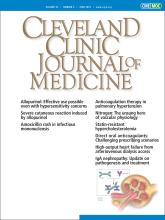ABSTRACT
Patients with COPD have an increased risk for severe COVID-19. Symptoms such as high-grade fever, anorexia, and myalgia may distinguish COVID-19 from dyspnea due to a COPD-related exacerbation. Management of COVID-19 in the patient with COPD may still warrant standard-of-care exacerbation treatment with antimicrobial agents and corticosteroids. Modalities to treat acute respiratory failure can be used with some caveats. Patients with COPD and COVID-19 infection who treat their illness at home should self-isolate, use nebulizers with precautions to avoid viral aerosolization, and frequently disinfect room surfaces.
COPD AND COVID-19
Chronic obstructive pulmonary disease (COPD) represents a large population of patients1 and is the fourth most common cause of death in the United States.2 Coexisting illnesses such as COPD increase the risk for severity of COVID-19,3,4 and a better understanding of the therapeutic implications for COVID-19 in the COPD population is needed.
Ways to distinguish early COVID-19-related viral dyspnea from a COPD exacerbation include the coexistence of flu-like symptoms not typically seen with COPD flare-ups, such as fever (89%),3 anorexia (40%), myalgias (35%), and gastrointestinal symptoms (40%).5
The use of corticosteroids increased viral shedding seen with the related coronaviruses MERS-CoV and SARS-CoV.6,7 Consequently, their administration was discouraged in COVID-19 with the prospect for harm.8 Nonetheless, a recent press release ahead of publication of a large randomized control trial in the United Kingdom announced that dexamethasone 6 mg IV daily given for 10 days reduced deaths by one-third in ventilated patients and by one-fifth in those receiving oxygen compared with standard care.9
While the full study has not yet been published, these findings are encouraging and suggest the role for corticosteroids in the treatment of COVID-19, particularly in the setting of a hyperactive immune response. Many COPD patients with history of exacerbations are maintained on inhaled corticosteroids as part of their outpatient therapy. There is currently no evidence of increased risk for SARS-CoV-2 infection for those individuals using inhaled corticosteroids.
While previous coronaviruses have been associated with COPD exacerbations,10 MERS-CoV, SARS-CoV, and COVID-19 have not been shown to cause COPD exacerbations. If a patient presents with a COPD exacerbation with concurrent COVID-19 infection, we recommend standard-of-care treatment with corticosteroids.11 Comorbid diabetes and hyperglycemia have also been associated with increased risk related to COVID-19,4,12 and glycemic control may be an additional challenge when using corticosteroids in this population.
The usual standard-of-care for acute respiratory failure in COPD involves nebulized bronchodilator therapy, noninvasive ventilation (NIV) and sometimes high flow nasal cannula (HFNC) prior to committing to invasive mechanical ventilation. There has been concern that these therapies increase aerosolization of SARS-CoV-2, thus increasing the risk of exposure of healthcare workers.13 We recommend inclusion of these therapies with the following precautions:
Patients should be switched to bronchodilator therapy through metered-dose inhalers or dry-powder inhalers in lieu of nebulization route whenever possible. Metered dose inhalers should be utilized with a spacer.
When using nebulized therapy, HFNC, and NIV, healthcare workers in the room should wear personal protective equipment appropriate for airborne precautions. NIV use should include inspiratory and expiratory viral filters.
Patients receiving HFNC should wear a surgical mask,14 which reduces air borne dispersion of exhaled particles.
The risk of COVID-19 aerosolization from HFNC appears to be minimal in preliminary studies using surgical mask during application.15⇓-17 While NIV use for acute respiratory distress syndrome (ARDS) is not considered standard of care,18 it is well recognized as treatment for acute hypercapnic respiratory failure secondary to COPD exacerbations and is associated with improvement in mortality rates.19 Therefore, we consider NIV as a reasonable initial choice for patients with COPD who present with increased work of breathing and hypercapnic respiratory failure in the setting of COVID-19.
HFNC usage is most beneficial in the setting of acute hypoxemic respiratory failure.20,21 However, we prefer the more established NIV in lieu of HFNC in the COPD patient with hypercapnic respiratory failure given the limited data available supporting utility of HFNC in this population.22⇓-24
COPD patients are particularly at risk for poor nutritional status25 and skeletal muscle loss, or sarco-penia.26 Those who develop ARDS from COVID-19 often require mechanical ventilation and neuro-muscular blockade which are both associated with intensive care unit-acquired weakness.27 Physical therapy and aggressive nutritional supplementation are extremely important to aid COPD patients during recovery from severe illness. Candid discussions with patients and families about advanced-care planning should be performed early.
A significant proportion of COPD patients with COVID-19 will treat their illness at home. For patients who remain home, it is very important to self-isolate in a room and ideally have their own bathroom. Using a nebulizer in the home has the potential to aerosolize COVID-19. Viral particles can persist as airborne particles for 1 to 3 hours.28 The nebulizer should be used in a room with the doors closed, and the room should be kept closed for several hours afterwards. Frequent cleaning and disinfection of the surfaces in the room should be undertaken. Patients with COPD can consider increasing the frequency of bronchodilator use during COVID-19 but should only do so after discussion with their healthcare provider.
Footnotes
The statements and opinions expressed in COVID-19 Curbside Consults are based on experience and the available literature as of the date posted. While we try to regularly update this content, any offered recommendations cannot be substituted for the clinical judgment of clinicians caring for individual patients.
- Copyright © 2020 The Cleveland Clinic Foundation. All Rights Reserved.






